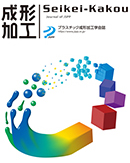
- |<
- <
- 1
- >
- >|
-
2018 Volume 30 Issue 12 Pages Index12_1-Index12_2
Published: November 20, 2018
Released on J-STAGE: August 25, 2020
JOURNAL FREE ACCESSDownload PDF (628K)
-
Tadahiro Kegasawa2018 Volume 30 Issue 12 Pages 605
Published: November 20, 2018
Released on J-STAGE: August 25, 2020
JOURNAL FREE ACCESSDownload PDF (612K)
-
Masato Yamamura2018 Volume 30 Issue 12 Pages 606-609
Published: November 20, 2018
Released on J-STAGE: August 25, 2020
JOURNAL FREE ACCESSDownload PDF (8556K) -
Isao Tada2018 Volume 30 Issue 12 Pages 610-615
Published: November 20, 2018
Released on J-STAGE: August 25, 2020
JOURNAL FREE ACCESSDownload PDF (959K) -
Kentaro Taki, Hiroshi Ito2018 Volume 30 Issue 12 Pages 616-619
Published: November 20, 2018
Released on J-STAGE: August 25, 2020
JOURNAL FREE ACCESSDownload PDF (823K) -
Tetsuo Tsuchiya, Hiroaki Noda, Hideo Goda, Jun Akedo2018 Volume 30 Issue 12 Pages 620-625
Published: November 20, 2018
Released on J-STAGE: August 25, 2020
JOURNAL FREE ACCESSDownload PDF (870K)
-
2.3 Injection Molding Specific Consideration, 2.4 Gate and Structure of Fixed Side MoldMitsuru Sakakibara2018 Volume 30 Issue 12 Pages 626-630
Published: November 20, 2018
Released on J-STAGE: August 25, 2020
JOURNAL FREE ACCESSDownload PDF (810K)
-
Go Aradono2018 Volume 30 Issue 12 Pages 631-634
Published: November 20, 2018
Released on J-STAGE: August 25, 2020
JOURNAL FREE ACCESSDownload PDF (3552K)
-
Isao Hosoya2018 Volume 30 Issue 12 Pages 635-636
Published: November 20, 2018
Released on J-STAGE: August 25, 2020
JOURNAL FREE ACCESSDownload PDF (1782K)
-
Kenji Aoki2018 Volume 30 Issue 12 Pages 637-639
Published: November 20, 2018
Released on J-STAGE: August 25, 2020
JOURNAL FREE ACCESSDownload PDF (3380K)
-
Takashi Sato2018 Volume 30 Issue 12 Pages 640-641
Published: November 20, 2018
Released on J-STAGE: August 25, 2020
JOURNAL FREE ACCESSDownload PDF (6458K)
-
Shigeru Owada, Hidetoshi Yokoi2018 Volume 30 Issue 12 Pages 642-649
Published: November 20, 2018
Released on J-STAGE: August 25, 2020
JOURNAL FREE ACCESSMolded products using a hot runner can have peculiar defects such as flow marks, gate marks, flow imbalance, and the like, caused by melt staying in the manifold channel. These phenomena have been noted, but the systematic analysis of their generation mechanisms have not been adequately shown. In this study, we focused on the generation mechanism of concentric flow marks around the gate that were observed on the surface of molded products using acrylonitrile-butadiene-styrene resin (ABS) with a side-fed type hot runner mold. An analysis was conducted using a dynamic flowing visualization method developed by the authors and a two-color molding method. A correlation between these flow patterns and flow mark generation areas was then derived. A unique stagnant behavior of the flow front was observed in the filling process, and it was thought that this caused a change in the deformation of the rubber particles in the melt during the transcription process. Results indicate a glossy unevenness on the surface. The stagnant behavior of the flow front was presumed to be a phenomenon that occurs due to the reversal of the temperature distribution between the inner and the outer layers of the cavity when the low-temperature, high-viscosity resin stagnating around the valve pin of the hot runner begins flowing into the cavity.
View full abstractDownload PDF (1145K)
-
2018 Volume 30 Issue 12 Pages 655
Published: November 20, 2018
Released on J-STAGE: December 27, 2023
JOURNAL FREE ACCESSDownload PDF (512K)
- |<
- <
- 1
- >
- >|